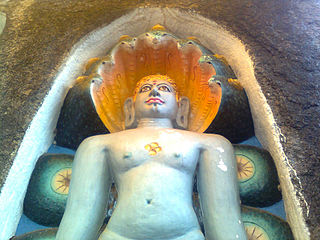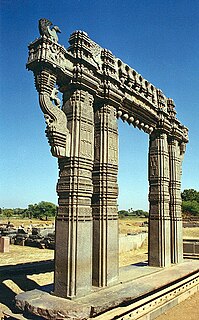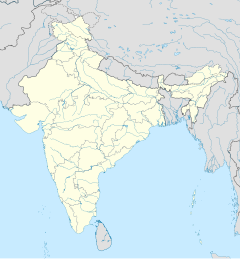
Nalgonda is a city and municipality in the Indian state of Telangana. It is the headquarters of the Nalgonda district, as well as the headquarters of the Nalgonda mandal in the Nalgonda revenue division.It is located about 90 kilometres (56 mi) from the state capital Hyderabad.

The Kakatiya dynasty was a South Indian dynasty whose capital was Orugallu, now known as Warangal. It was eventually conquered by the Delhi Sultanate.

Hanmakonda is a neighbourhood and one of the three cities constituting the Tri-City of Warangal in the Indian state of Telangana. It is administered by Greater Warangal Municipal Corporation.

The Chennakeshava Temple, also referred to as Keshava, Kesava or Vijayanarayana Temple of Belur, is a 12th-century Hindu temple in the Hassan district of Karnataka state, India. It was commissioned by King Vishnuvardhana in 1117 CE, on the banks of the Yagachi River in Belur also called Velapura, an early Hoysala Empire capital. The temple was built over three generations and took 103 years to finish. It was repeatedly damaged and plundered during wars, repeatedly rebuilt and repaired over its history. It is 35 km from Hassan city and about 200 km from Bengaluru.

Jambukeswarar Temple, Thiruvanaikaval is a famous Shiva temple in Tiruchirapalli (Trichy) district, in the state of Tamil Nadu, India. The temple was built by Maaravarman Sundharapandi I, a pandiyan king, around 800 years ago. Though it is speculated that Kocengannan, one of the Early Cholas, to have built this temple, there is no evidence to support it. It is located in the Srirangam island, which has the famous Ranganathaswamy temple.

Panagal or Panagallu is a historic town located 4 km from Nalgonda town in Telangana, India. Panagal was one of the capitals of Kunduru Chodas who ruled parts of eastern Telangana in the 11th and 12th centuries.
Jayapa Nayudu or Jayapa Senani was a military commander under Ganapatideva, the Kakatiya king who had given some districts to Jayapa Nayudu to rule the present-day Andhra Pradesh and Telangana during the medieval period from his seat in Warangal. He was a major player in the Kakatiya Empire.

Marundeeswarar Temple is a temple dedicated to Hindu deity Shiva, located in Thiruvanmiyur, Chennai adjacent to the beach of Bay of Bengal. It is one of the 275 Paadal Petra Sthalams and no Navagraha where the two of the most revered Nayanars, Appar and Tirugnana Sambandar have glorified the temple with their verses during the 7th-8th century. The temple has been widely expanded by Chola kings during the 11th century. The temple has two seven tiered gateway towers, a huge tank, with the overall temple area covering 1 acre. The Marundeeswarar temple has been a place of curative worship for people with diseases.

The Kasivisvesvara temple and sometimes called Kashivishvanatha temple is located in Lakkundi, in the of Karnataka state, India. It is 11 km from Gadag city, 24 km from Dambal and about 50 km from Kuknur.

The Thousand Pillar Temple or Rudreswara Swamy Temple is a historic Hindu temple located in the town of Hanamakonda, Telangana State, India. It is dedicated to Lord Shiva, Vishnu and Surya. Thousand Pillar Temple, along with Warangal Fort, Kakatiya Kala Thoranam and Ramappa Temple are added to the tentative list of World Heritage sites recognised by UNESCO.

Warangal Fort is located in Warangal District, Telangana, India. It was the capital city of Kakatiyas and Musunuri Nayakas. It appears to have existed since at least the 12th century when it was the capital of the Kakatiya dynasty. The fort has four ornamental gates, known as Kakatiya Kala Thoranam, that originally formed the entrances to a now ruined great Shiva temple. The Kakatiyan arch has been adopted and officially incorporated into the emblem of Telangana after the state bifurcation. The Fort is included in the "tentative list" of UNESCO World Heritage Site. The Monument was submitted by the Permanent Delegation of India to UNESCO on 10/09/2010.
Panagal Archaeological Museum is an archaeological museum located in Panagal village in Nalgonda district, Telangana, India. It is located in the premises of Pachala Someswara temple. It is also close to the Chaya Someswara temple at a distance of 1.3 km to the west of the temple.

Chaya Someswara temple, also known as Trikutalayam, is a Saivite Hindu temple located in Panagal, Nalgonda district of Telangana, India. It is a popular pilgrimage site during Maha Sivaratri. The temple has three sanctum sanctorum and hence is also called Trikutalayam. The temple has stepped pyramidal sikharas and was probably built in the 11th and 12th centuries CE during the rule of Kunduru Chodas and Prataparudra I of Kakatiya Empire over the Panagal region.
Telangana State Tourism Development Corporation (TSTDC) is a state government agency which promotes tourism in Telangana, a state in the Southern region of India. The retired Director General of Police Pervaram Ramulu is the appointed First chairman of Telangana State Tourism. Tourist attractions in Telangana include historical places, monuments, forts, water falls, forests and temples.

The Culture of Telangana in India has a cultural history of about 5,000 years. The region emerged as the foremost centre of culture in Indian subcontinent during the rule of Kakatiya, the Qutb Shahi and Asaf Jahi dynasties—. The rulers' patronage and interest for arts and culture transformed Telangana into a unique multi-cultural region where two different cultures coexist together, thus making Telangana the representative of the Deccan Plateau and its heritage with Warangal and Hyderabad being its epicenter. The regions' major cultural events celebrated are "Kakatiya Festival" and Deccan Festival along with religious festivals Bonalu, Bathukamma, Dasara, Ugadi, Sankranthi, Milad un Nabi and Ramadan.
Warangal ASI Museum is a museum located in the musical garden complex in Warangal, Telangana, India. It is maintained by Archaeological Survey of India.

Pushpagiri Temple Complex is a temple complex located in Kadapa district in Andhra Pradesh, India. Founded around 7th Century CE, it houses some of the oldest temple congregations in the region. It is not to be confused with the Buddhist Pushpagiri Vihara ruins in Odisha.
Khilla Ghanpur is a historic place equidistant, 25 km, from Mahabubnagar and Wanaparthy towns of Telangana state, India. It is 111 kilometers away from Hyderabad city.
Kodeesvarar Temple is a Hindu temple dedicated to the deity Shiva, located at Kothangudi in Nagapattinam district in Tamil Nadu, India.

Erakeswara Temple is a Saivite Hindu temple located in Pillalamarri, Suryapet district of Telangana, India. The temple is built on the banks of the Musi river. Erakeswara temple is one among the three prominent temples located in Pillalamarri village - the other two being Nameswara temple and Trikuta temple. Erakeswara temple was built during the early 13th century by the Recherla chiefs who were the feudatories of Kakatiyas. The main deity of the temple is Lord Chennakesava, a form of Lord Siva.






















